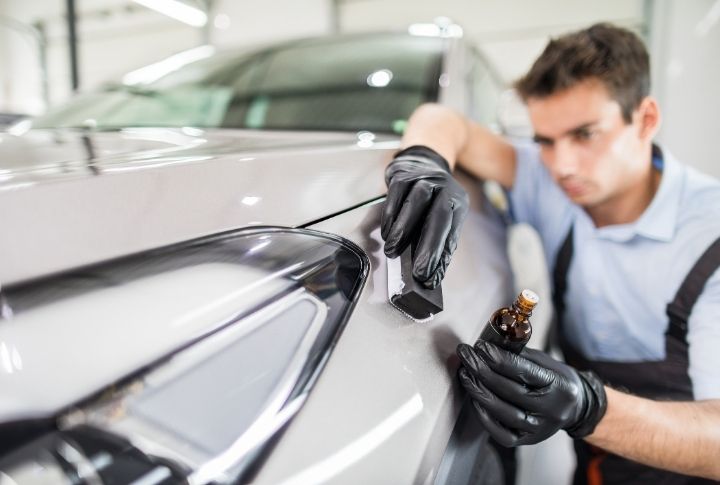
Everything You Need To Know About Ceramic Coating for Cars

Picture your car gleaming like a freshly polished jewel, with water beading up and rolling right off and dirt seemingly disappearing into thin air. That’s the power of a ceramic coat! If you’ve ever dreamed of having a car that looks showroom-ready for weeks on end, with minimal washing effort, then this advanced sealant is the solution you’ve been searching for. This guide will be your roadmap to leveling up your car care game.
Definition and Benefits

Ceramic coating is an advanced protective layer applied to your car’s paintwork, creating an impenetrable barrier against the elements. This innovative technology repels water, UV rays, and everyday wear to maintain a showroom shine for months. Unlike traditional wax or sealants, it forms a durable bond with the paint, providing unparalleled protection and ease of maintenance.
Types of Coatings

There are various types of ceramic coatings available, each with its own unique characteristics and advantages. Paint protection, water-repellent glass, conditioned leather, stain-resistant fabric, and protected wheels. Ceramic wax combines traditional wax and ceramic technology. Each provides specific benefits for different surfaces to cater to different needs.
Selecting the Right Brand and Product

When selecting a ceramic coating brand and product, define your budget, goals, and desired durability. Consider the level of shine and gloss you want and whether you want a product with a warranty. Choose a product that meets your taste and needs and follow the instructions for application.
Application Methods

Applying a ceramic coating can be a DIY project or a professional service. DIY coatings are applied by hand or with a microfiber applicator, while professional coatings are applied by trained technicians in a controlled environment using specialized equipment. Following instructions and taking precautions ensure a successful application.
Step-by-Step DIY Application

The DIY ceramic coating application process involves preparing the surface, polishing the paint, cleaning and degreasing, applying a thin layer of coating, working in sections, removing excess, inspecting and repeating as needed, and finishing and curing the coating. Adhering to the manufacturer’s guidelines is important for achieving optimal results.
Preparation and Cleaning

Start by washing the vehicle with mild soap, then use a clay bar to take out contaminants and polish the paint to remove imperfections. Remove any trim or emblems and use a solvent-based cleaner to remove oils and residue. Finally, wipe down the surface with a microfiber cloth to ensure it’s free of dust, dirt, and other contaminants.
Maintenance and Aftercare

To maintain the protective layer, avoid harsh chemicals and abrasive materials, wash with mild soap, and dry with a microfiber towel. Use a gentle detail spray to maintain hydrophobic properties. Avoid applying wax or sealants on top. Regularly inspect for damage and reapply as needed.
Cost and Value

The cost of nano shields for vehicles varies based on factors like vehicle size, paintwork condition, and product quality. To get the best value, obtain quotes from multiple providers, research their experience and certifications, and consider recommendations from friends or online reviews.
Common Mistakes to Avoid

When applying a ceramic coating, avoid common mistakes like coating in extreme temperatures or humidity, applying too much, exposing to moisture before curing, skipping prep work, and incorrect layering. Also, avoid applying in direct sunlight or on a hot surface, and wait for the recommended curing time.
Durability and Longevity

A quality protective layer can last 2-5 years or more, depending on application and maintenance. It shields paintwork and clear coat from the elements, UV rays, and everyday wear, providing a strong barrier. Proper care can extend its lifespan, with some lasting up to 7 years.
Comparison to Waxing and Sealing

Ceramic coating offers superior protection (up to 5 years) and hydrophobic properties but is expensive and difficult to apply. Waxing boosts paint depth and vibrancy but only provides 4-8 weeks of protection. In comparison to ceramic coatings, sealing offers better protection (6-12 months) and a shiny finish, but does not offer the same durability as ceramic coatings.
Removal and Correction

Removal and correction can be complex and challenging. Removal requires specialized tools and techniques, while correction involves wet sanding or polishing to fix unevenness or hazing. Prevention is key, as the right application and maintenance help to avoid mistakes.
Troubleshooting Common Issues

Common issues include hazing (improper application), streaks (insufficient prep work), water spotting (mineral deposits), and scratches (improper application or paint correction). To fix these issues, reapply, ensure adequate prep work, use a water spot remover, or reapply with proper paint correction.
Warranty Information

Typical coverage ranges from 1-10 years, depending on the product and manufacturer. Coverage often includes fading, staining, and light scratches. Annual inspections are usually required. Failure to inspect may void coverage. Check the manufacturer’s terms for details.
Environmental Impact

The eco-friendliness of products varies, with some posing environmental risks if not disposed of carefully. Sustainable materials and lower carbon footprints offset this. Recycling and responsible disposal minimize impact. Ethical consumption supports a more sustainable future.


